ISSN ONLINE(2319-8753)PRINT(2347-6710)
ISSN ONLINE(2319-8753)PRINT(2347-6710)
M.Jegajothi1, C.Mahendran2
|
| Related article at Pubmed, Scholar Google |
Visit for more related articles at International Journal of Innovative Research in Science, Engineering and Technology
Design of Compact planar wideband antenna suitable for wireless universal serial bus (USB) dongle application is proposed in this communication. By simply cutting notches and engrafting types of slots into a rectangular patch introduces multiple resonances. When these are combined together, the bandwidth gets enhanced. The proposed microstrip patch antenna has wide bandwidth with 10-dB return-loss and covering the range from 4.8768 to 8.9523 GHz. 59% of bandwidth could be achieved with the aid of simple microstrip Line feeding technique with VSWR<2. These features make them very suitable for wireless local area networks (WLANs) applications. This design has an overall size of only 11× 15 ×0.8 mm3 and is very suitable for use in an USB device.
Keywords |
| notch, slot, universal serial bus (USB), VSWR, wireless local area networks (WLANs). |
INTRODUCTION |
| Recently there is considerable interest in developing such high data rate systems known as wideband communication systems. Meanwhile, considering that the Universal Serial Bus (USB) is a well-adopted portable connectivity tool in data exchange between various consumer electronics and mobile devices, much attention is therefore being focused on the wideband operation in the wireless USB dongle device. Compared to the conventional USB devices, the new realized wireless wideband USB dongle has a potential function to provide short-range and high-data communication without requiring a wire simultaneously among a wide range of devices. Prepared for this scenario to arrive, the constraint of a conventional USB dongle and the limitation of the latest technology in a wireless USB device, which are the necessity of a cable and the limitation of a narrow bandwidth, respectively, have to be resolved. For this, the trend of integrating the USB dongle with both the wireless technology and the wideband operation is suggested as a competitive service. However, one of the major key technologies in constructing such a wideband USB dongle is to achieve an antenna with not only wide bandwidth, but also a miniaturized size to be incorporated in the device’s extremely limited space. During the past years, only a few related wideband USB antennas have been proposed. These include the modified meander-strip and an inverted L-strip type [1] & [9], the dual-folded strips type [2], |
| The microstrip-fed patch types [3]-[8] &[10], etc. However, most of these designs still have either a complex structure or a large size for being built into the compact space of a USB dongle device. This letter is thus aimed at describing the design and realization of a compact wideband antenna suitable for use in the USB dongle. Meanwhile, regarding that the microstrip patch antennas are widely used due to their inherent advantages of low profile, light weight and low cost. Due to that microstrip patch antennas are increasing in popularity for use in wireless applications. In this paper we have presented the use of a patch antenna with U-shaped slot to achieve wideband application with compact size and very low return loss. The VSWR parameter was found to be less than 2 within the operating frequency range. It can be used for wireless Local Area Network application in the frequency range 5.2 to 5.8 GHz. By properly selecting dimensions of the notches as well as the embedded slots, good wide impedance bandwidth and suitable radiation characteristics for application in the WLAN system can be achieved. Effects of cutting notches and embedding slots to the original patch on resonance were studied. Also, measurement of the proposed antenna working across the operating frequencies was implemented for verifying the simulation results. |
II. ANTENNA DESIGN AND DISCUSSIONS |
| Fig.1 illustrates the geometry of the synthesized wideband microstrip-fed slotted patch antenna. A rectangular patch as a radiator was etched on the top portion of one side of an FR4 substrate with initial dimensions of 37 (L )× 15 (W ) mm2 , which is in general approaching the size of a portable USB dongle device, whereas the ground plane with a size of Lg×W was printed on the other side of the substrate. The specified characteristics of this substrate are 0.8 mm in thickness and 4.4 in relative permittivity (Ãâ°Ãâºr). A 50-Ω microstrip line of width Ws and length (Ls) was then adopted for feeding the patch. For improving the matching condition and then effectively extending the impedance bandwidth, dual triangular notches, each with dimensions of Ln×Wn, were cut at the two lower corners of the patch. Thereafter, to further enhance the bandwidth U slot were embedded into the notched patch. |
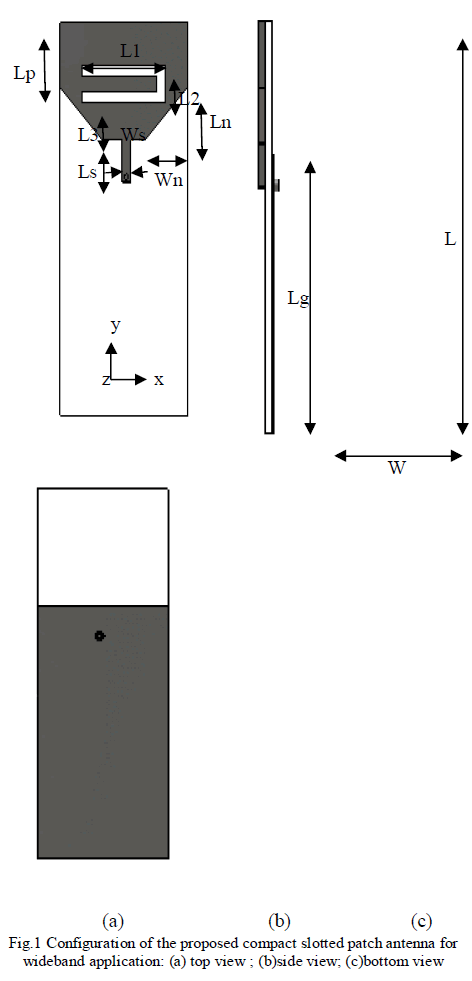 |
| Optimal geometrical parameters of the proposed wideband antenna are shown in table 1. Here, width of 1 mm was selected for the U slot. |
 |
| This is because the slot has been found to be an effective way to excite additional resonances and to thus produce a continuous wide bandwidth of about 4.07 GHz (defined for 10-dB return loss) ranging from 4.87 to 8.95GHz. The obtained band sufficiently covers WLAN and ISM standard. |
III. SIMULATION RESULTS |
| Design evolution of the proposed wide band antenna on simulated frequency response of return loss is shown in figure 2. It begins with the design of an antenna with a rectangular patch of 11 (Lp) × 15 (W) mm2, with respect to the center frequency (6 GHz) of the desired Wireless band. When cutting a triangular notch of 5 (Ln) × 5 (Wn) mm2 in size at each of the two lower-sides corners and embedded with U slots to increase the mode excitation as well as extend the whole bandwidth. Obviously, once the U slots were simultaneously embedded into the notched patch multiple resonances are excited and accordingly provide an wide impedance bandwidth of about 4.0755GHz (defined for 10-dB return loss), ranging from 4.87-8.95GHz. The obtained operating band sufficiently covers the requirement of the wireless standard. |
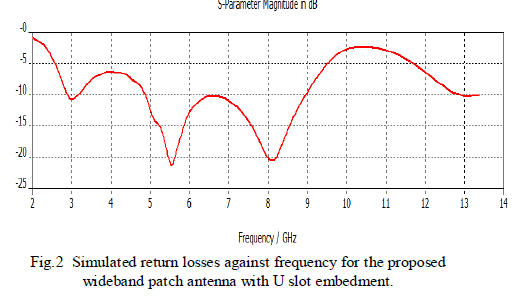 |
| 59% of bandwidth was obtained from the proposed wideband microstrip patch antenna according |
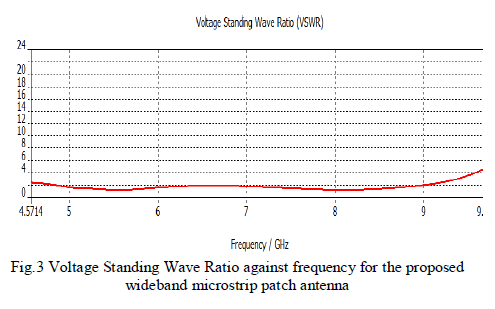 |
| Fig.3 shows that the antenna frequency bandwidth with VSWR<2 covers the frequency range of 4.87 to 8.95 GHz. This agrees with the less than –10 dB band of the return loss. |
| Since a microstrip patch antenna radiates normal to its patch surface, the elevation pattern for phi = 0o (H-plane) and phi = 90o (E-plane) degrees would be important. Fig.4. shows the radiation field Pattern of the antenna under consideration in the (x-z) plane (phi = 0o) and the (y-z) plane (phi =90o) at the operating resonance of 5.25 GHz |
| It is noticed that at the operating resonance the maximum radiation is obtained in the broadside direction for both |
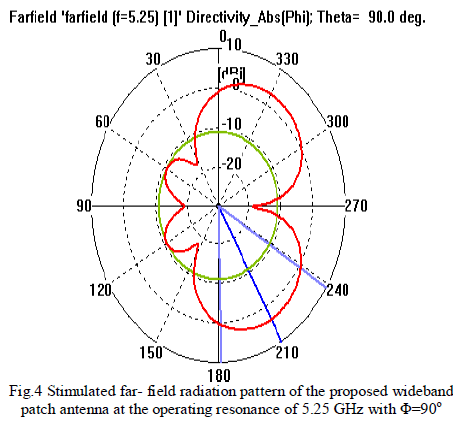 |
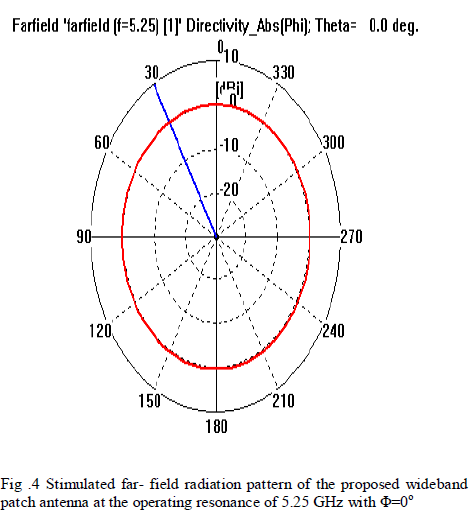 |
| This low back-lobe radiation is an added advantage for using this antenna in a cellular phone, since it reduces the amount of electromagnetic radiation which travels towards the users head, it is noticed that the beam-width in both planes is wide enough. |
IV.CONCLUSIONS |
| A miniaturized microstrip-fed planar patch antenna designed by simply notching and slotting the patch for wideband operation has been presented and applications in the 4.87 to 8.95 GHz bandwidth are pursued using FDTD simulator. With an antenna size of only 11 ×15 mm2, multi resonance having wide bandwidth and suitable radiation performance to cater for the wireless standard used in a USB dongle device is achieved. Also, the proposed wideband microstrip patch antenna provides different parameters like return loss, VSWR and radiation pattern. The feeding technique utilized in this design is the coaxial probe-feed. The main advantage of this type of feeding scheme is that the feed can be placed at any desired location inside the patch in order to match with its input impedance. This feed method is easy to fabricate and has low spurious radiation. Such antenna configurations are very useful in the wireless communications industry. |
| Because of their low cost, light weight and ease of implementation, these printed designs are desired in wideband wireless communication systems and applications, especially in portable devices and indoor applications such as wireless local area networks (WLANs). |